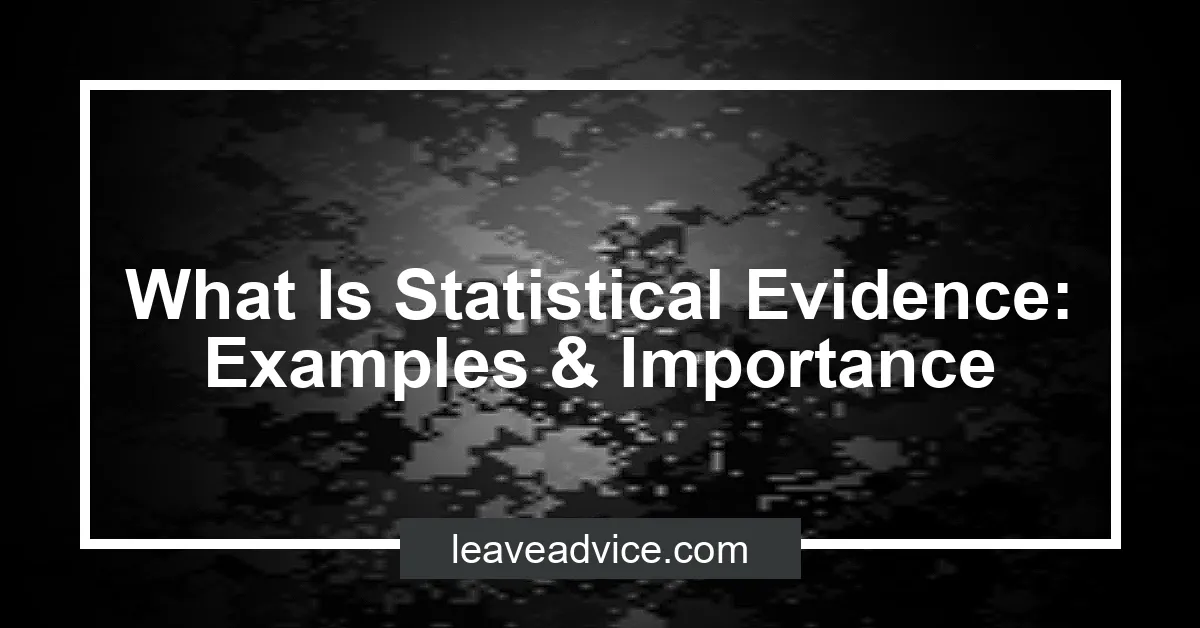What Is Statistical Evidence: Examples & Importance


Statistical evidence refers to a collection of observations organized and validated for mathematical expression. It is used in research and decision-making to support claims or arguments with numerical data and statistical analysis.
Statistical evidence is important because it provides a reliable and objective basis for drawing conclusions, formulating policies, and making informed decisions. It helps to quantify and measure the likelihood or impact of certain outcomes, making it a valuable tool in various fields such as medicine, public policy, and business.
By using statistical evidence, researchers, policymakers, and decision-makers can assess the validity and reliability of their findings, leading to more accurate and evidence-based conclusions. This helps to ensure that decisions are well-informed, supported by data, and have a higher chance of achieving the desired outcomes.
Understanding Statistical Evidence
Statistical evidence constitutes a collection of organized and validated observations expressed in mathematical form. It serves as a summary of opinions or observations by subject-matter experts.
This type of evidence uses numerical data and statistical analysis to support an argument or claim, aiding in the evaluation of hypotheses and estimation of unknowns.
What constitutes statistical evidence
Statistical evidence comprises data that is aggregated, organized, and validated to summarize opinions or observations of subject-matter experts in mathematical form. It involves the use of numerical data and statistical analysis to support arguments or claims.
Types of statistical evidence
The types of statistical evidence include surveys, polls, census data, experiment results, economic data, crime statistics, and evidence derived from statistical techniques such as frequentist and Bayesian theories. These types of evidence enable the differentiation between reasonable and dubious conclusions and help in providing a basis for conclusions.
The role of statistics in providing evidence
Statistics plays a crucial role in research, clinical practice, and decision-making processes. It aids in judging the quality and cost-effectiveness of care delivered and provides a foundation for drawing conclusions.
Moreover, statistics allow the examination of evidence from stochastic populations to improve understanding of the world, making it an essential tool in evidence-based decision making.
| Type of Statistical Evidence | Description |
|---|---|
| Surveys | Data collection method through questionnaires or interviews |
| Polls | Collection of data from a sample population for analysis |
| Census Data | Official counts of a particular population |
| Experiment Results | Outcomes from controlled studies or trials |
| Economic Data | Information related to economic activities |
| Crime Statistics | Statistical data on criminal activities |
Examples of Statistical Evidence
Real-life examples of statistical evidence
In a real-life example, a study conducted by Content Marketing Institute revealed that 91% of B2B marketers and 86% of B2C marketers use content marketing to reach their audience. This statistical evidence proves the effectiveness and widespread adoption of content marketing in the business world.
Case studies demonstrating the use of statistical evidence
An illustrative case study from Optimove demonstrated a statistically significant increase in customer engagement and conversion rates following the implementation of a personalized marketing campaign fueled by data-driven insights. This case study showcases the tangible impact of statistical evidence on marketing decision-making and business outcomes.
| Statistical Evidence Example | Key Insight |
|---|---|
| Content Marketing Survey Results | High adoption rates & effectiveness |
| Optimove Marketing Campaign Case Study | Tangible impact on customer engagement & conversion rates |
These real-life examples and case studies vividly highlight the power of statistical evidence in informing strategic decision-making and driving positive outcomes in the realm of content marketing and business engagement.
Importance of Statistical Evidence in Decision Making
Statistical evidence plays a crucial role in shaping decision making processes by offering concrete, quantifiable data to support various choices. When faced with complex decisions, statistical evidence informs and guides the selection of the most effective and efficient courses of action.
By analyzing historical data and identifying patterns, decision makers are empowered to make well-informed choices based on tangible evidence rather than intuition or guesswork.
How statistical evidence informs decision making
Statistical evidence informs decision making by providing a factual basis for assessing risks and potential outcomes. It enables decision makers to evaluate the likelihood and impact of various options, facilitating effective risk assessment.
Additionally, statistical evidence allows for trend analysis, enabling decision makers to forecast future developments and allocate resources efficiently. Decision making based on statistical evidence is thus grounded in concrete, measurable data rather than subjective judgment.
The impact of statistical evidence on policy-making
In the realm of policy-making, statistical evidence serves as a cornerstone for evidence-based decision making. It provides invaluable insights into social reality, facilitating the identification of correlations and trends crucial for informing policy design.
Moreover, statistical evidence aids in establishing numerical benchmarks, enabling effective monitoring and evaluation of policy or program progress. By utilizing statistical evidence, policy makers can ensure that their decisions are backed by tangible data and are aligned with the desired outcomes.
Reliability of Statistical Evidence
Statistical evidence’s reliability is influenced by several factors, including the source of the data, the consistency of the measure over time (test-retest reliability), and the method’s resistance to external factors. For instance, respondents’ varying moods or changing external conditions can impact the reliability of the data.
These factors must be carefully considered to ensure the trustworthiness and consistency of statistical evidence.
Factors influencing the reliability of statistical evidence
The reliability of statistical evidence can be influenced by the source of the data, the consistency of the measure over time, and the method’s resistance to external factors. For example, if the source of the data is unreliable or if the measure exhibits inconsistency over time, then the reliability of the statistical evidence is compromised.
Ensuring data integrity and consistency is crucial to enhance the reliability of statistical evidence.
Assessing the validity of statistical evidence
Assessing the validity of statistical evidence involves examining how accurately a method measures what it is intended to measure. High reliability is an indicator of validity, as it signifies accuracy in the measurement process.
By employing different types of evidence, such as criterion validity, researchers can ensure that their statistical evidence accurately corresponds to real properties and variations in the physical or social world.
Limitations of Statistical Evidence
Statistical evidence in research is prone to common pitfalls in interpretation, leading to skewed conclusions and misleading outcomes. A common pitfall is the failure to show differences between treatment groups, often attributed to smaller than necessary sample sizes.
This can result in misinterpreted statistical significance, where even small treatment effects may appear significant due to large sample sizes, masking the clinical relevance. Furthermore, interpreting comparisons between two effects without direct comparison can lead to erroneous conclusions.
Common pitfalls in the interpretation of statistical evidence
Common pitfalls in the interpretation of statistical evidence include the failure to demonstrate differences between treatment groups, often due to smaller sample sizes than required and misinterpreted statistical significance. Moreover, comparing two effects without direct comparison can also lead to misleading conclusions.
The potential for misuse of statistical evidence
The potential for misuse of statistical evidence is significant, particularly in the fields of marketing, politics, and media. Misleading statistics are often employed intentionally or by error, leading to false narratives and deceptive information.
This misuse can occur in various forms, including incorrect application of statistical tests, lack of transparency, and incomplete/incorrect data utilization.
The Ethical Considerations of Statistical Evidence
Ethical implications of using statistical evidence
The ethical implications of using statistical evidence are paramount in maintaining the integrity of research and analysis. Researchers must ensure the honesty and transparency of their scientific communications, including the accurate reporting of data, results, methods, and publication status.
Fabricating, falsifying, or misrepresenting data is strictly prohibited, emphasizing the need for honesty and integrity in statistical practices. Additionally, ethical statistical practitioners should acknowledge and mitigate any known or suspected limitations, defects, or biases in the data and methods, effectively communicating the potential impacts on interpretation, conclusions, and recommendations.
This commitment to ethical conduct safeguards the reliability and credibility of statistical evidence.
The responsibility of researchers and analysts in handling statistical evidence
Researchers and analysts bear the responsibility of upholding ethical standards in handling statistical evidence. By acknowledging and addressing any potential limitations, defects, or biases in the data and methods, they contribute to the integrity and reliability of statistical analyses.
Moreover, researchers must respect the rights and interests of human and animal subjects, minimizing harms and risks while maximizing benefits during research. The ethical statistical practitioner promotes the sharing of data and methods, ensuring transparency and accountability in their work.
The responsibility lies in maintaining transparency, honesty, and ethical conduct throughout the entire process of utilizing statistical evidence.
Historical Significance of Statistical Evidence
Milestones in the development of statistical evidence
The development of statistical evidence has seen significant milestones throughout history. One such milestone is the creation of the database, which enabled statistical analysis by allowing the examination of trends over time.
This development marked a crucial turning point in the utilization of statistical evidence to derive meaningful insights and make informed decisions.
Another crucial milestone in the development of statistical evidence is the establishment of evidence-informed milestones for developmental surveillance. This step aimed to provide a framework for monitoring child development, leading to the identification of evidence-based milestone ages.
Such milestones have played a pivotal role in promoting healthy development and addressing potential concerns at early stages.
The evolution of statistical evidence in different fields
The evolution of statistical evidence has had a profound impact across various fields, particularly in the behavioral and social sciences. Statistical methods have been instrumental in collecting, representing, and analyzing data, contributing to a wide array of research initiatives in these domains.
This evolution has significantly enhanced the depth and quality of insights derived from behavioral and social sciences research.
Moreover, statistical evidence has proven to be influential in decision-making processes. Its importance lies in transforming vast data into actionable information, providing the basis for informed decision-making.
In the context of evidence-based decision-making in fields such as medicine and public health, statistical evidence has played a crucial role in underpinning decisions with the best available data.
| Fields | Impact of Statistical Evidence |
|---|---|
| Behavioral and Social Sciences | Contributed to diverse research initiatives |
| Decision-making and Public Health | Underpinned decisions with the best available data |
The contributions of statistical evidence across these fields underscore its profound evolution, highlighting its transformative impact on decision-making and research endeavors.
Statistical Evidence in Law and Criminal Justice
The role of statistical evidence in legal proceedings
Statistical evidence plays a crucial role in legal proceedings by providing measurable data to support or challenge claims. It aids in identifying correlations, probabilities, and patterns, offering insights into the likelihood of events or the validity of claims.
Lawyers and judges use statistical evidence to strengthen their arguments, especially in cases involving complex data or large sample sizes. It helps in evaluating the reliability of evidence, determining causation, and assessing the credibility of witness testimonies.
Statistical evidence contributes to fostering a more informed and evidence-based legal system.
Famous cases where statistical evidence played a crucial role
One notable case where statistical evidence had a significant impact is the “Simpson-Goldman civil trial” where statistical analysis of blood drops and DNA evidence played a pivotal role. Another famous case is the “US Tobacco litigation” where statistical evidence regarding the health risks of smoking influenced the outcome of the trial.
Additionally, the “Ford Pinto case” utilized statistical evidence to assess the cost-benefit analysis of recalling defective vehicles. These cases showcase how statistical evidence can sway legal outcomes and highlight the importance of incorporating data-driven analyses in legal proceedings.
Statistical Evidence in Public Health
How statistical evidence informs public health initiatives
Statistical evidence plays a crucial role in informing public health initiatives by providing quantitative data on the prevalence and impact of health issues within a community. For example, through statistical analysis, public health officials can identify trends in disease prevalence, behavioral risk factors, and healthcare disparities, which then inform the development of targeted intervention strategies.
By analyzing statistical evidence, public health initiatives can be more precisely tailored to address the specific needs of diverse population groups, maximizing their effectiveness in promoting overall health and well-being.
The impact of statistical evidence on healthcare policies
The impact of statistical evidence on healthcare policies is profound, as it serves as the foundation for evidence-based decision-making. Statistical data guides policymakers in understanding the scope and severity of public health challenges, ensuring that resources are allocated effectively.
For instance, statistical evidence can demonstrate the cost-effectiveness of preventative measures, leading to the implementation of policies aimed at mitigating health risks. Moreover, statistical evidence is instrumental in evaluating the success of healthcare policies, enabling adjustments to be made based on tangible data.
Statistical evidence empowers policymakers to make informed choices that positively influence the health outcomes of entire populations.
The Use of Statistical Evidence in Business
How businesses utilize statistical evidence for decision making
Statistical evidence plays a crucial role in enabling businesses to make informed and strategic decisions. By leveraging statistical analyses, organizations can assess historical data to identify patterns, correlations, and trends that inform critical business choices.
For example, retail businesses utilize statistical evidence to forecast consumer demand, leading to optimized inventory management and enhanced customer satisfaction. Moreover, in the financial sector, statistical evidence aids in risk assessment, allowing for more accurate and profitable investment decisions based on historical market behaviors.
Another instance of statistical evidence in decision-making can be observed in marketing strategies, where businesses use data-driven insights to target specific consumer demographics, leading to higher conversion rates and improved return on investment. Statistical evidence empowers businesses to shift from intuition-based decision-making to an approach grounded in empirical evidence, leading to more successful and sustainable outcomes.
The impact of statistical evidence on business growth and strategy
The impact of statistical evidence on business growth and strategy is profound, as it enables organizations to identify and capitalize on opportunities for expansion and improvement. By utilizing statistical analyses, companies can measure the effectiveness of various initiatives, such as marketing campaigns, product launches, or operational changes.
For example, a company can use statistical evidence to analyze customer retention rates and align marketing efforts with those findings, resulting in sustained growth and revenue expansion.
In addition, statistical evidence facilitates strategic resource allocation by providing insights into the most efficient and effective utilization of resources. This can be seen in manufacturing companies optimizing production processes based on statistical evidence, leading to increased output and cost savings.
Furthermore, statistical evidence aids in the identification of new markets and sales opportunities, contributing to long-term business growth and development.
The effective use of statistical evidence in decision-making and business strategy has a significant impact on organizational growth and success, enabling businesses to make sound, data-informed choices that drive sustainable development and competitive advantage. By utilizing statistical evidence, businesses can navigate challenges, capitalize on opportunities, and pave the way for continued prosperity.
| Benefits of Statistical Evidence in Business Decision-Making |
|---|
| Informed decision-making based on data-driven insights |
| Enhanced risk assessment for profitable investment decisions |
| Targeted marketing strategies leading to higher conversion rates and ROI |
| Optimization of resource allocation for increased efficiency |
| Identification of new markets and sales opportunities |
Statistical Evidence in Social Sciences
The application of statistical evidence in sociology, psychology, and anthropology
Statistical evidence plays a crucial role in sociology, psychology, and anthropology by providing quantitative support to various social phenomena. In sociology, statistical data aids in analyzing demographic trends, societal behavior, and social inequality, allowing researchers to draw evidence-based conclusions about societal structures.
In psychology, statistical evidence facilitates the empirical validation of theories, enabling the identification of psychological patterns and trends within populations. In anthropology, statistical methods help in understanding cultural diversity, kinship structures, and migration patterns prevalent in different societies.
Challenges and opportunities in using statistical evidence in social sciences
The use of statistical evidence in social sciences presents both challenges and opportunities. One challenge is the potential misinterpretation of statistical data, leading to inaccurate conclusions and societal implications.
However, a clear opportunity lies in leveraging advanced statistical techniques to comprehend complex societal dynamics and predict behavioral patterns. Additionally, the extensive availability of digital data opens doors to innovative statistical analyses, offering unprecedented insights into human behavior and societal interactions.
Statistical Evidence in Environmental Studies
The role of statistical evidence in environmental research
Statistical evidence plays a critical role in environmental research by enabling the analysis of complex relationships between variables. Methods such as linear regression models, generalized linear models, and non-linear models are commonly utilized to examine the intricate interactions within environmental systems.
For example, these statistical techniques can help determine the correlation between carbon emissions and global temperature changes, providing empirical evidence essential for public policy development.
Statistical evidence in environmental policy-making
In environmental policy-making, statistical evidence serves as the foundation for informed decision-making. By applying statistical methods to environmental data, policymakers can gain insights into crucial factors such as air and water quality, climate patterns, and soil health.
This evidence-driven approach enables the formulation of sustainable environmental policies that address pressing issues while considering economic impacts. For instance, robust statistical evidence can support the implementation of effective environmental regulations by demonstrating the relationship between policy interventions and their outcomes.
| Statistical Model | Application in Environmental Research |
|---|---|
| Linear regression | Assessing the impact of pollution on climate |
| Generalized models | Analyzing biodiversity in changing ecosystems |
| Non-linear models | Studying the dynamics of natural resource usage |
By leveraging statistical evidence, environmental research and policy-making can advance toward evidence-based solutions that promote environmental sustainability while considering economic and social implications.
The Future of Statistical Evidence
Emerging trends in statistical evidence
Data Visualization: The display of data in a visual format, such as charts or graphs, helps in understanding complex data sets more effectively.
Bayesian Statistics: This approach allows for the incorporation of prior knowledge and updating beliefs based on new evidence, enhancing the accuracy of statistical inferences.
Causal Inference: The focus on understanding causal relationships between variables rather than mere correlations, leading to more insightful and actionable conclusions.
Data Ethics: With the increasing use of data, emphasis on ethical considerations related to data collection, storage, and usage is becoming crucial to maintain trust and integrity.
The potential for innovation in statistical evidence gathering and analysis
Innovative Data Collection Methods: Utilizing technologies such as satellite imagery, blockchain, and mobile applications for more timely and accurate data collection, revolutionizing traditional methods.
Artificial Intelligence and Machine Learning: Integration of AI and machine learning into statistical analysis for enhanced predictive modeling, pattern recognition, and uncovering deeper insights from large datasets.
Real-Time Analytics: The ability to analyze data as it is generated, providing immediate insights for decision-making and proactive measures.
Data Privacy and Security: Addressing the growing concerns around safeguarding sensitive data, ensuring compliance with regulations and maintaining trust with stakeholders.
| Trend | Impact |
|---|---|
| Artificial Intelligence | Empowers predictive modeling and deeper insights from datasets |
| Data Visualization | Enhances comprehension of complex data through visual representation |
| Real-Time Analytics | Provides immediate insights for proactive decision-making |
| Data Ethics | Ensures ethical considerations in data collection, storage, and usage |
Embracing these emerging trends and innovations in statistical evidence will drive a paradigm shift in data analysis, fostering more accurate, ethical, and impactful decision-making across various industries and domains.
Recommended Amazon Products for Understanding Statistical Evidence
Here’s a curated list of products that can help you understand statistical evidence with ease. These recommendations are based on quality, relevance to statistical evidence, and customer reviews.
Calculator – Texas Instruments TI-84 Plus CE Graphing Calculator
The Texas Instruments TI-84 Plus CE Graphing Calculator is an essential tool for statistical analysis. With its ability to graph and visualize data, it is a valuable asset for understanding statistical evidence.
Pros and Cons:
| Pros | Cons |
|---|---|
| High resolution, full-color backlit display | Relatively high price |
| Rechargeable battery | Learning curve for first-time users |
| Preloaded apps for statistical analysis | Not compatible with ACT test |
Book – “Statistics” by Robert S. Witte and John S. Witte
“Statistics” by Robert S. Witte and John S. Witte is a comprehensive guide to statistical concepts and evidence. It provides in-depth explanations and examples that are beneficial for gaining a thorough understanding of statistical evidence.
Pros and Cons:
| Pros | Cons |
|---|---|
| Comprehensive coverage of statistical topics | Large and heavy book |
| Clear and accessible writing style | No digital version available |
| Practical examples and exercises | May be overwhelming for beginners |
Software – SPSS (Statistical Package for the Social Sciences)
SPSS is a widely-used software for statistical analysis, making it a valuable tool for understanding statistical evidence. Its user-friendly interface and extensive range of analysis options cater to both beginners and advanced users.
Pros and Cons:
| Pros | Cons |
|---|---|
| Versatile and powerful statistical analysis tools | High cost for full version |
| User-friendly interface with intuitive design | Steeper learning curve for beginners |
| Wide range of data visualization options | Requires a subscription for continuous use |
Course – “Statistics for Data Science and Business Analysis” on Udemy
The “Statistics for Data Science and Business Analysis” course on Udemy provides a comprehensive learning experience for statistical analysis. It covers practical applications of statistics in data science and business, making it a valuable resource for understanding statistical evidence.
Pros and Cons:
| Pros | Cons |
|---|---|
| Practical applications relevant to real-world scenarios | Not a physical product |
| Self-paced learning with lifetime access | Variable quality depending on instructor |
| Affordable pricing compared to traditional courses | Limited interaction with instructors |
Reference Card – Quick Study QuickStudy Statistics Equations & Answers Laminated Study Guide
The QuickStudy Statistics Equations & Answers Laminated Study Guide is a handy reference tool for statistical equations and concepts. Its concise format and durability make it a convenient resource for quick access to statistical information.
Pros and Cons:
| Pros | Cons |
|---|---|
| Compact and portable design | Limited depth of content |
| Laminated for durability | Limited to basic equations and answers |
| Quick access to key statistical information | Not a comprehensive learning resource |
Top Recommended Product for Understanding Statistical Evidence
If you’re looking for the best solution for understanding statistical evidence, we highly recommend the Texas Instruments TI-84 Plus CE Graphing Calculator. Its practical functionality, high-resolution display, and preloaded apps for statistical analysis make it an invaluable tool for comprehending statistical evidence.
Ready to improve your understanding of statistical evidence? Check out the Texas Instruments TI-84 Plus CE Graphing Calculator today for the best results!


Conclusion
Statistical evidence refers to the data and information that is collected, analyzed, and interpreted to support or refute a hypothesis, claim, or decision. It provides a quantitative basis for understanding and making inferences about a population or a phenomenon, using mathematical and computational techniques to draw valid and reliable conclusions.
Furthermore, statistical evidence plays a crucial role in various fields such as business, science, healthcare, and public policy, as it helps in making informed decisions, identifying trends and patterns, and testing the significance of relationships. By using statistical evidence, professionals can assess the probability and variability of outcomes, evaluate the effectiveness of interventions, and optimize processes for achieving desired outcomes.
Statistical evidence serves as a foundation for drawing reliable conclusions and making data-driven decisions. It enables researchers, analysts, and policymakers to understand the relationships between variables, make predictions, and assess the strength of evidence in support of a hypothesis, ultimately contributing to the advancement of knowledge and the improvement of practices.




